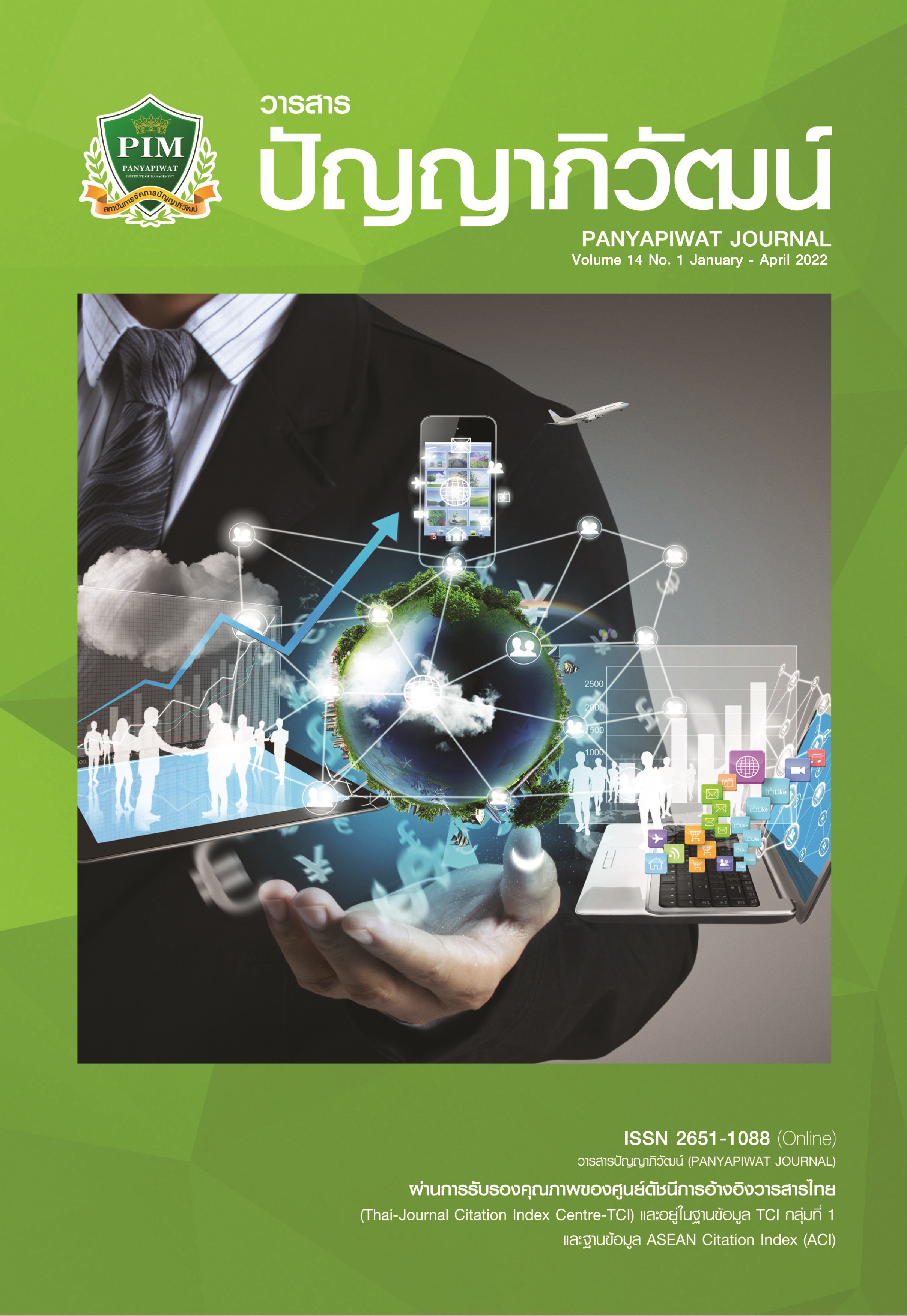อิทธิพลของสมรรถนะด้านการจัดการและด้านการตลาดที่มีต่อผลการดำเนินงานทางธุรกิจ ของวิสาหกิจชุมชนฮาลาลใน 3 จังหวัดชายแดนภาคใต้ โดยมีการรับรู้ความสามารถของผู้ประกอบการเป็นตัวแปรกำกับ
Main Article Content
บทคัดย่อ
การวิจัยครั้งนี้มีวัตถุประสงค์เพื่อ 1) เพื่อศึกษาอิทธิพลของสมรรถนะด้านการจัดการและสมรรถนะ ด้านการตลาดที่มีต่อผลการดำเนินงานทางธุรกิจของวิสาหกิจชุมชนฮาลาลใน 3 จังหวัดชายแดนภาคใต้ และ 2) เพื่อทดสอบอิทธิพลของสมรรถนะด้านการจัดการและสมรรถนะด้านการตลาดมีต่อผลการดำเนินงานทางธุรกิจของวิสาหกิจชุมชนฮาลาลใน 3 จังหวัดชายแดนภาคใต้ โดยมีตัวแปรการรับรู้ความสามารถของผู้ประกอบการเป็นตัวแปรกำกับ โดยเก็บข้อมูลจากผู้ประกอบการวิสาหกิจชุมชนฮาลาลใน 3 จังหวัดชายแดนภาคใต้ ได้แก่ จังหวัดปัตตานี จังหวัดยะลา และจังหวัดนราธิวาส จำนวน 394 คน อาศัยวิธีสุ่มตัวอย่างแบบอาศัยความน่าจะเป็น (Probability Random Sampling) ด้วยวิธีการสุ่มแบบแบ่งช่วงชั้น (Stratified Random Sampling) และวิเคราะห์ข้อมูลด้วยเทคนิคการวิเคราะห์โมเดลสมการโครงสร้าง (Structural Equation Modeling: SEM)
ผลการวิจัยพบว่า แบบจำลองสมการโครงสร้างมีความกลมกลืนกับข้อมูลเชิงประจักษ์ (χ2/df = 2.457, TLI = 0.956, CFI = 0.955, RMSEA = 0.057) โดยปัจจัยสมรรถนะด้านการจัดการและด้านการตลาดมีอิทธิพลต่อผลการดำเนินงานทางธุรกิจของวิสาหกิจชุมชนฮาลาลใน 3 จังหวัดชายแดนภาคใต้ นอกจากนี้ผลการทดสอบของอิทธิพลตัวแปรกำกับพบว่า การรับรู้ความสามารถของผู้ประกอบการมีอิทธิพลกำกับความสัมพันธ์ระหว่างสมรรถนะด้านการจัดการและด้านการตลาดต่อผลการดำเนินงานทางธุรกิจของวิสาหกิจชุมชนฮาลาลใน3 จังหวัดชายแดนภาคใต้อย่างมีนัยสำคัญทางสติถิ
Article Details

อนุญาตภายใต้เงื่อนไข Creative Commons Attribution-NonCommercial-NoDerivatives 4.0 International License.
“ข้าพเจ้าและผู้เขียนร่วม (ถ้ามี) ขอรับรองว่า บทความที่เสนอมานี้ยังไม่เคยได้รับการตีพิมพ์และไม่ได้อยู่ระหว่างกระบวนการพิจารณาลงตีพิมพ์ในวารสารหรือแหล่งเผยแพร่อื่นใด ข้าพเจ้าและผู้เขียนร่วมยอมรับหลักเกณฑ์การพิจารณาต้นฉบับ ทั้งยินยอมให้กองบรรณาธิการมีสิทธิ์พิจารณาและตรวจแก้ต้นฉบับได้ตามที่เห็นสมควร พร้อมนี้ขอมอบลิขสิทธิ์บทความที่ได้รับการตีพิมพ์ให้แก่สถาบันการจัดการปัญญาภิวัฒน์หากมีการฟ้องร้องเรื่องการละเมิดลิขสิทธิ์เกี่ยวกับภาพ กราฟ ข้อความส่วนใดส่วนหนึ่งและ/หรือข้อคิดเห็นที่ปรากฏในบทความข้าพเจ้าและผู้เขียนร่วมยินยอมรับผิดชอบแต่เพียงฝ่ายเดียว”
เอกสารอ้างอิง
Abdul Rasool, M. S., & Mat Isa, N. A. (2020). The moderating effects of self-efficacy between physical activity towards employee’s well-being during COVID-19 pandemic: A conceptual framework. European Journal of Molecular & Clinical Medicine, 7(6), 1575-1583.
Academic Focus. (2018). Promotion and development of community enterprises. Parliament. https://www.parliament.go.th/library [in Thai]
Ali, M., & Qun, W. (2019). Strategic management practices and performance of the SME’s in Bangladesh. International Journal of Advanced Research, 7(1), 69-78.
Alraja, M. N., Khan, S. F., Khassab, B., & Aldaas, R. (2020). Does facebook commerce enhance SMEs performance? A structural equation analysis of Omani SMEs. SAGE Open, 10(1), 1-14.
Adede, O. A., Kibera, F. N., & Owino, J. O. (2017). Electronic marketing practices, competitive environment and performance of telecommunications companies in Kenya. British Journal of Marketing Studies, 5(5), 60-67.
Aragón-Sánchez, A., & Sánchez-Marín, G. (2005). Strategic orientation, management characteristics, and performance: A study of Spanish firms. Journal of Small Business Management, 43(3), 287-308.
Atchara, M., & Boonthawan, W. (2015). Role of leadership and member participation in driving toward the strength of sewing community enterprises, Ban Mae Hawl, Hangchat District, Lampang Province. Humanity and Social Science Journal (GTHJ.), 21(3), 20-31. [in Thai]
Awang, Z. H. (2010). Research methodology for business and social science. Pusat Penerbitan University.
Bandura, A. (1977). Self-efficacy. Toward a unifying theory of behavioral change. Psychological Review, 84(2), 191-215.
Barney, J. (1991). Firm resources and sustained competitive advantage. Journal of management, 17(1), 99-120.
Baron, R. M., & Kenny, D. A. (1986). The Moderator-mediator variable distinction in social psychological research: Conceptual, strategic, and statistical considerations. Journal of Personality and Social Psychology, 51(6), 1173-1182.
Chinda, K. (2018). Personnel development in community enterprise of Phetchabun Province. Pathumthani University Academic Journal, 10(2), 71-81. [in Thai]
Chrisman, J. J., Bauerschmidt, A., & Hofer, C. W. (1998). The determinants of new venture performance: An extended model. Entrepreneurship Theory and Practice, 23, 5-30.
Collins, D. D. (2007). Entrepreneurial success: The effect of fear on human performance [Doctoral dissertation]. Capella University.
Community Enterprise Promotion Division, Department of Agricultural Extension. (2020). An assessment of the potential of community enterprises at the end of quartile 4 in 2020. http://www.sceb.doae.go.th/Documents/SSV/Evaluation%20CE/Evaluation%20CE_2563_4.pdf [in Thai]
Daniel, C. O. (2018). The effects of marketing strategies on organizational performance. International Journal of Business Marketing and Management, 3(9), 1-9.
Department of Agricultural Extension. (2020). Overview report of community enterprise potential assessment. http://www.sceb.doae.go.th/Documents/SSV/Evaluation%20CE/EvaluationCE_2563_2.pdf [in Thai]
Dodokh, A., & Al-Maaitah, M. A. (2019). Impact of social media usage on organizational performance in the jordanian dead sea cosmetic sector. European Journal of Business and Management, 11(2), 75-91.
Forth, J., & Bryson, A. (2019). Management practices and SME performance. Scottish Journal of Political Economy, 66(4), 1-32.
Hair, J. F., Black, W. C., Babin, B. J., & Anderson, R. E. (2010). Multivariate data analysis (7th ed.). Pearson Prentice Hall.
Hadiyati, E., & Lukiyanto, K. (2019). The effect of entrepreneurial marketing dimensions on micro, small and medium enterprise performance in Indonesia. International Journal of Scientific & Technology Researc, 8(10), 106-112.
Juma, M. (2018). Factors affecting the competitiveness of small and medium Muslim entrepreneur in three southern border provinces. Journal of Pacific Institute of Management Science, 4(1), 218-230. [in Thai]
Kenu, A. Z. (2018). Effect of marketing mix strategy on performance of SMEs evidence from selected manufacturing enterprises in Southern region, Ethiopia. International Journal of Science and Research (IJSR), 8(12), 1129-1133.
Kline. R. B. (2011). Principles and practice of structural equation modelling. The Guilford Press.
Mahmood, R., & Bakar, H. A. (2016). Examining strategic improvisation and performance relationship in the SMEs: Moderating role of entrepreneurial self-efficacy. International Business Management, 10(13), 2535-2540.
Makara-Studzinska, M., Golonka, K., & Izydorczyk, B. (2019). Self-efficacy as a moderator between stress and professional burnout in firefighters. International Journal of Environmental Research and Public Health, 16(2), 1-16.
Nuh, R., Noipom, T., & Hasama, H. (2020). Causal factors affecting business performance of halal community enterprise: The case study of 3 Provinces of Southern Border. Journal of Business Administration, 43(168), 58-82.
Orser, B., & Riding, A. (2003). Management competencies and SME performance criteria: A pilot study. Industry Canada.
Phothinam, P. (2017). The study of managerial development of community enterprise in Kalasin Province. Journal of the Way Human Society, 5(1), 191-200. [in Thai]
Registration and Community Enterprise Information. (2020). The summary of the number of registered community enterprises and community enterprise networks. http://www.sceb.doae.go.th/Documents/STC/311063.pdf [in Thai]
Rovinelli, R. J., & Hambleton, R. K. (1977). On the use of content specialists in the assessment of criterion referenced test item validity. Dutch Journal of Educational Research, 2, 49-60.
Soenanto, T. W., Hamzah, D., Muis, M., & Brasit, N. (2016). The influence of telecommuting systems, self-efficacy and the quality of management on work productivity and the competitiveness of organizational perspectives in multinational companies in Jakarta, Indonesia. Scientific Research Journal (SCIRJ), 4(3), 43-52.
Tantasuntisakul, W. (2015). Determinants of business performance among women entrepreneurs in Southern Thailand [Doctoral dissertation]. University Utara Malaysia.
Yalo, M. I., Enimola, D. J., & Nafiu, A. T. (2019). Effects of marketing strategies on the performance of small and medium-scale enterprises in Kogi State. International Journal of Research and Innovation in Social Science (IJRISS), 3(2), 445-451.
Yamane, T. (1967). Statistics, an introductory analysis (2nd ed.). Harper and Row.
Yusuff, Y. Z., Mohamad, M., & Ab Wahab, N. T. (2019). The influence of general self-efficacy on women entrepreneurs. Academy of Entrepreneurship Journal, 25(2), 1-6.


